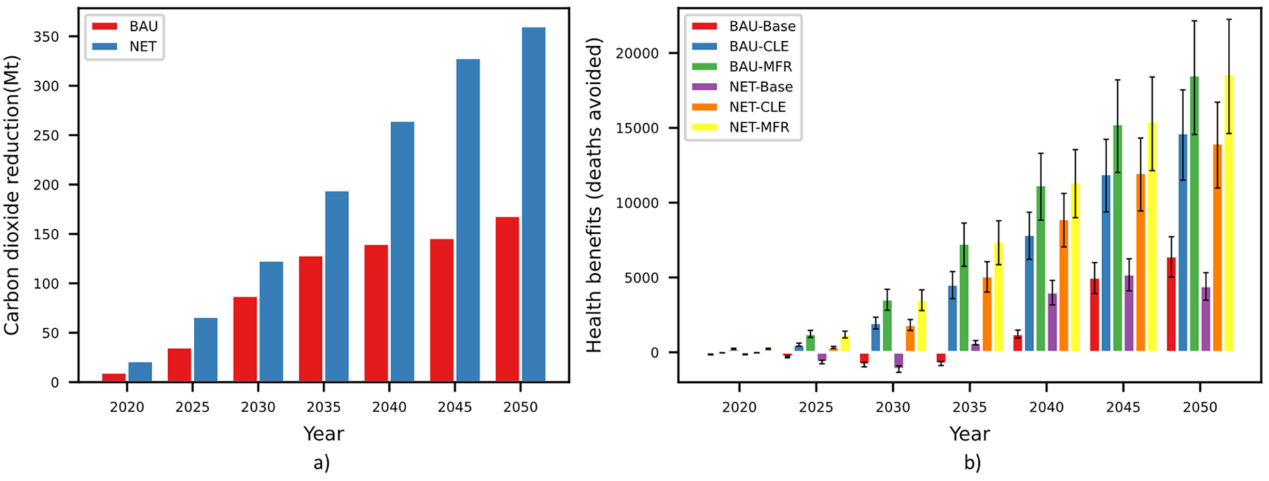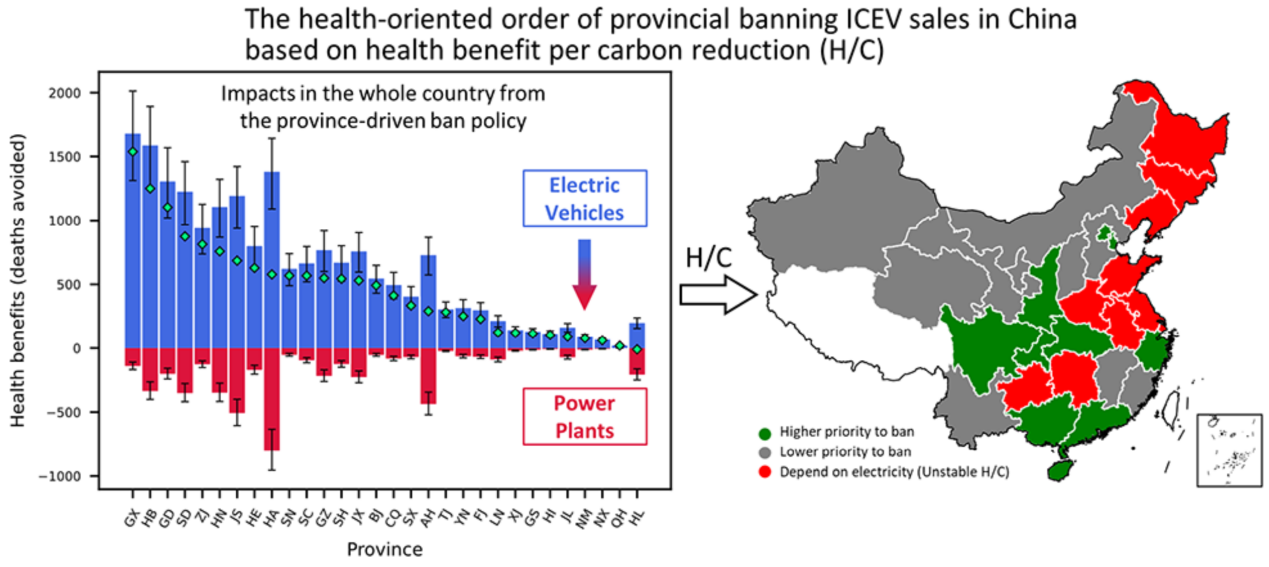Reducing the use of internal combustion engine vehicles (ICEVs) is an important link in the making of carbon mitigation policies in the transport sector. Estimating the carbon mitigation and health cobenefits from the banning of ICEVs across different provinces is of great significance to the formulation of the “step-by-step” strategies and optimization of policy efficiency. Therefore, Cai Wenjia’s Research Group of the Department of Earth System Science (DESS), Tsinghua University conducts research on the health-oriented order of provincial banning ICEV sales in the private vehicle sector in China, and explores the carbon mitigation and health cobenefits of banning ICEV sales in different provinces of China. The results were published online in Environmental Science & Technology on January 6 in an article titled “Incorporating Health Cobenefits into Province-Driven Climate Policy: A Case of Banning New Internal Combustion Engine Vehicle Sales in China”.
An integrated assessment framework with a passenger transportation accounting model, environment, an electrical system optimization model, and an air quality assessment model and a health impact assessment model has been built. On this basis, a comparison scenario about whether the ICEVs sales will be banned by 2035 (the ban policy) and six electrical sector combination scenarios with two carbon mitigation strengths and three air pollutant end treatment strengths have been designed in the study to explore the carbon mitigation and health cobenefits of the provincial banning of ICEV sales in China and calculate the health benefits per carbon reduction (H/C) of each province.

Fig. 1. Total carbon dioxide reduction and health cobenefits under different electricity scenarios due to the ICEV sales ban policy in the private car sector in China
The research results show that, with the realization of net zero emission in the electricity sector, by 2050, the policy of banning ICEV sales will bring almost twice as much carbon mitigation to the road transport sector in China. Judging from the interannual changes, whether the electricity sector achieves net zero emissions will have a significant impact on the carbon emission of the ICEV ban policy after 2035. The main factor affecting health benefits is the end treatment of air pollutants. With the strengthening of air pollutant emission control in the electricity sector, the health benefit gap between the two electricity sector carbon mitigation scenarios will be narrowed. From the perspective of interannual changes, the greater the carbon mitigation goal of the electricity sector, the greater the health benefits will ensue after 2035.

Fig. 2. The health benefits of provincial banning ICEV sales in China and suggestion on the order of related policies
It is pointed out in the research that the regional and sectoral distributions of CO2 reduction and health benefits due to a province-driven ban are greatly uneven. For regional differences, the top five provinces would take up to over one-third of the total impact generally. If the national average air pollutant emissions per unit of electricity generated could be reduced to 29.9% and 32.5% of that in 2015 (base year), it is estimated that by 2050, the provincial ICEV sales ban policy will bring health benefits to China. The research further calculated the health benefits per carbon reduction (H/C) of each province, and found that the difference of H/C among provinces in China was as high as 8 times. According to the H/C ranking, three provinces with stable and high ranking (High, green area in the figure), stable and low ranking (Low, gray area in the figure) and significant change with the electricity sector (Change, red area in the figure) are identified and compared with the available research. It is proposed in the study that the southeast coastal provinces (Guangdong, Guangxi, Hainan and Zhejiang), Hubei, Sichuan, Chongqing, Shaanxi, Beijing and Tianjin be encouraged to implement the no-burning policy first to maximize health benefits.
Shen Jianxiang, a doctoral student in the DESS, Tsinghua University, is the first author of the article, and Professor Cai Wenjia is the corresponding author. Co-authors include doctoral student Li Haoran, postdoctoral fellows Cui Xueqin and Zhang Shihui, Professor Wang Chan and doctoral students Bu Chujie and An Kangxin of Tsinghua University School of Environment, and senior engineer Chen Xiaotong of Global Energy Internet Development Cooperation Organization. This research is supported by the National Natural Science Foundation of China, Tsinghua-RioTinto Joint Research Center for Resources and Energy Foundation.
Full-text link: https://pubs.acs.org/doi/10.1021/acs.est.2c08450
Written by Shen Jianxiang